What are the 2 divisions of the nervous system?
- central nervous system (CNS)
- peripheral nervous system (PNS)
What is the central nervous system (CNS)?
“command centre”
brain and spinal cord
processes and integrates info
What does the peripheral nervous system consist of?
- cranial nerves: to/from brain
- spinal nerves: to/from spinal cord
What are the 2 divisions of the peripheral nervous system (PNS)?
- sensory/afferent division
- motor/efferent division
What do afferent and efferent mean?
afferent: info from the body coming to central nervous system
efferent: info from the central nervous system to body, to initiate action
What does the sensory/afferent division on the PNS do?
has sensory receptors that detect stimuli (change in internal or external environments)
What does the motor/efferent division on the PNS do?
nerves convey impulses away from CNS
innervates (supplies nerves to) effectors = muscles and glands (endocrine or exocrine)
What is the relationship between CNS and PNS?
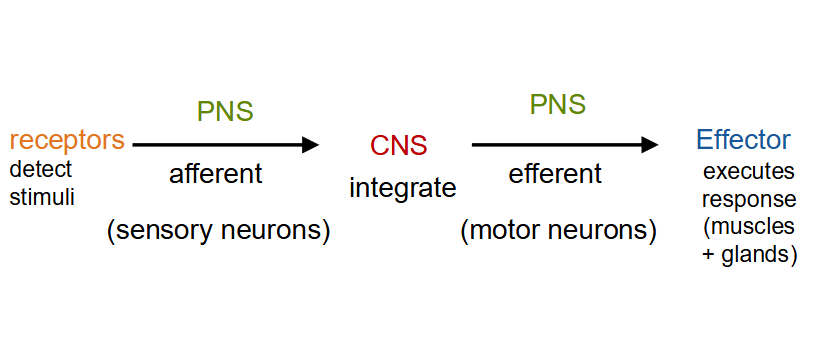
What is the nervous system organization?
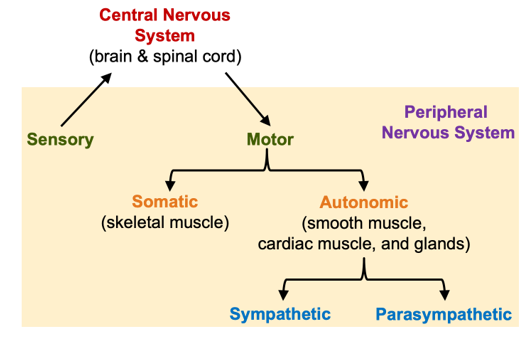
What are the different cell types in the nervous system?
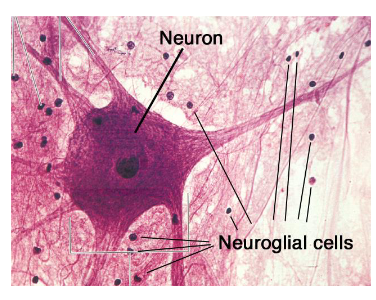
Neurons and neuroglia (glial cells)
What do neurons do?
conduct impulses
make up CNS and PNS
mostly amitotic (irreplaceable)
o exceptions = taste, olfaction, memory
What is the structure of the cell body of the neuron?
typical organelles
RER called - Nissl Bodies
groups/clusters in CNS = nuclei (gray matter)
groups/clusters in PNS = ganglia
What are the two processes of the cell body of a neuron?
dendrites and axon
What do dendrites do?
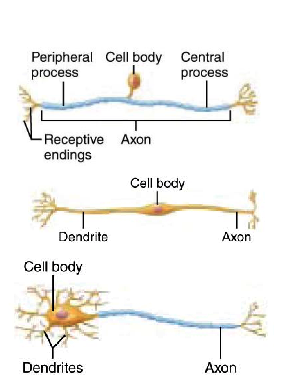
receive incoming messages and relay to cell body
What do axon do?
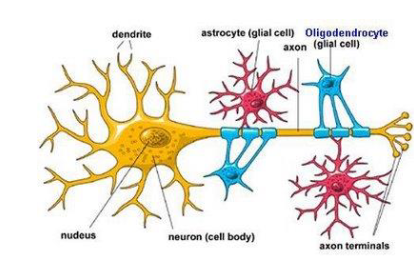
carry impulses away from cell body
What are axon hillock and axon terminal?
axon hillock = where axon meets cell body
axon terminal = typically branched with synaptic end bulbs (enlarged tips)
What does myelinated mean for axon?
- they may be myelinated or unmyelinated (just no myelin)
- myelinated - – wrapped in many layers of cell membrane from Schwann cells (PNS) or oligodendrocytes (CNS)
- myelinated axon bundles in:
o CNS = tracts (white matter)
o PNS = nerves
What does myelin do for axons?
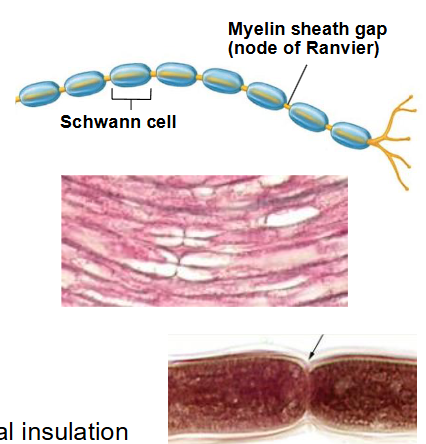
- electrical insulation
- gaps in myelin sheath are called Nodes of Ranvier
What do neuroglia cells do?
support neuron cells = can undergo mitosis (prone to cancer – brain tumor)
What are the two types of glial cells?
- CNS neuroglia
- PNS neuroglia
What are the cells in CNS neuroglia?
oligodendrocytes, microglia, astrocytes, and ependymal (neural epithelia)
What do oligodendrocytes do?
produce myelin around axon
What do microglia do?
protective – become phagocytic if detect infected, dead, or damaged neurons (because immune cells can’t enter CNS)
What do astrocytes do?
surround blood capillaries to form part of blood brain barrier (BBB)
help control capillary permeability
What does ependymal do(neural epithelia)?
line brain ventricles and central canal of the spinal cord
secrete cerebrospinal fluid (CSF) and circulate it (cilia)
What are the cells in PNS neuroglia? What do they do?
- Schwann cells: form myelin around axons in PNS
- Satellite cells: surround neuron cell bodies in ganglia – protection and support
What are the neuron classifications?
Structural/Anatomical types and Functional types
What is Structural/Anatomical type of neuron classification based on and what are the types?
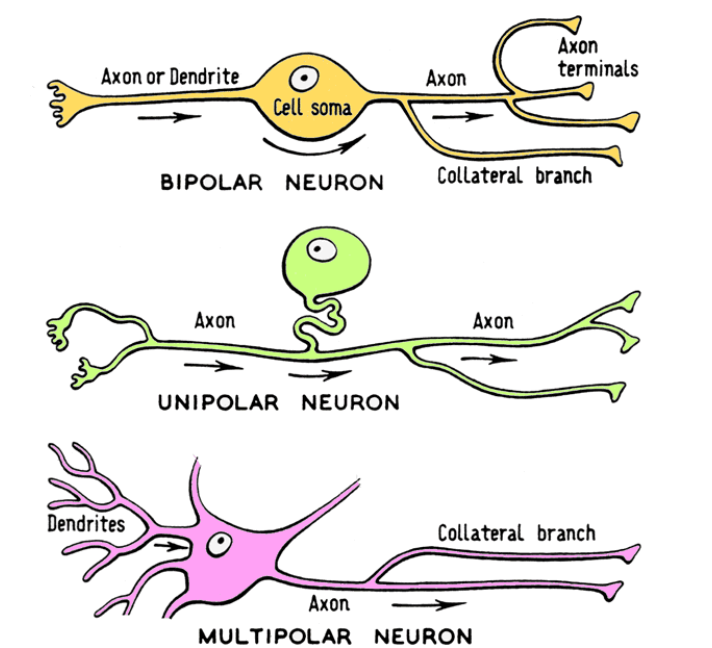
- based on # of cell processes off of cell body
- Unipolar, Bipolar, and Multipolar
What are the features of Unipolar cell bodies?
1 process that divides into two: central and peripheral
peripheral end has dendrites = sensory receptors (pain, touch etc) - remainder is axon
always sensory
What are the features of Bipolar cell bodies?
2 processes: 1 axon, 1 process with dendrites
sensory – retina, nose (olfaction)
What are the features of multipolar cell bodies?
3 or more processes: 1 axon, many dendrites
all interneurons and motor neurons
What is functional type of neuron classification based on and what are the types?
- based on direction of impulse conduction
- types: Sensory/Afferent Neurons, Interneurons, Motor/Efferent Neurons
What are the characteristics of sensory/afferent neurons?
mostly unipolar
from sensory receptors to CNS
What are the characteristics of interneurons?
- within CNS (between sensory and motor)
- 99% of neurons (mostly multipolar)
What are the characteristics of motor/efferent neurons?
- CNS to effectors (all multipolar)
- effectors are parts of the body that respond to stimuli (muscles, glands, etc)
What are the 3 kinds of neuron junctions (synapses)?
1) Neuronal junction:
2) Neuromuscular junction:
3) Neuroglandular junction:
What are the neuronal junctions between?
neuron to neuron
can be chemical (use neurotransmitters) or electrical (ions)
What is the neuromuscular junction between?
motor neuron to skeletal muscle
What is the neuroglandular junction between?
motor neuron to gland
What are chemical neuronal synapses?
- the most common neuron junction
- a structure of: Presynaptic Neuron, Axon Terminal, Synaptic Cleft, Postsynaptic Neuron
What is a presynaptic neuron?
neuron bringing impulse
Where is the axon terminal? What does it contain?
within synaptic end bulbs
o inside the end bulb (presynaptic membrane) = synaptic vesicles containing neurotransmitter (nt)
What is a synaptic cleft?
space between neurons
What is a Postsynaptic Neuron?
receives the impulse
has postsynaptic membrane, which is a cell membrane of dendrites or cell body with receptor sites for nt
How to the PNS and CNS nervous system communicate in terms of histology?
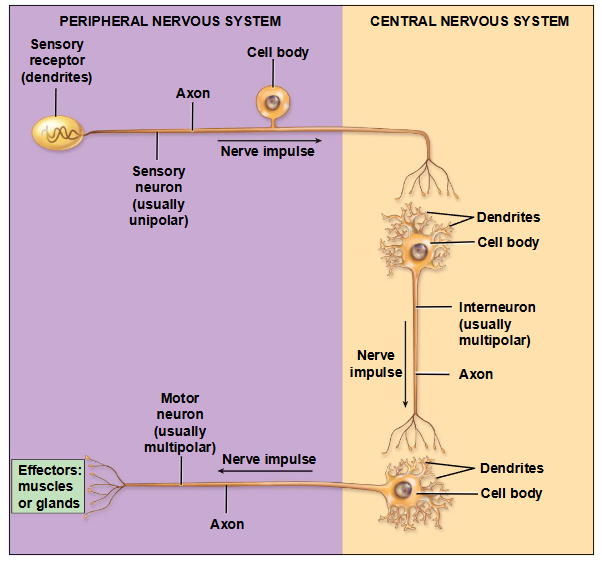
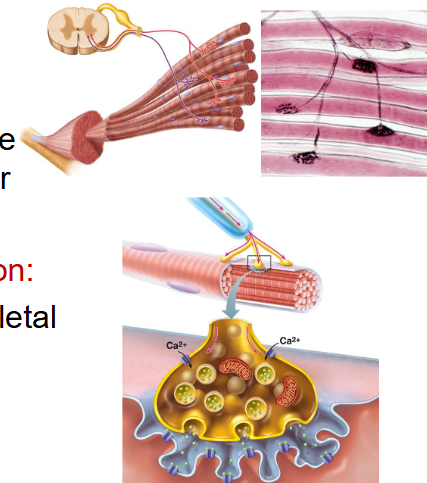
What neuron junction is this?
- neuromuscular junction